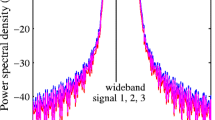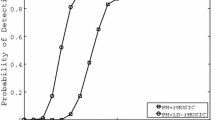Abstract
Direction of arrival estimation of LFM signal is an essential task in radar, sonar, acoustics and biomedical. In this paper, a short time Fourier transform multi-step knowledge aided iterative generalized minimum residual (STFT-MS-KAI-GMRES) approach is presented to amend the angle measurement of this signal. A three stage algorithm is proposed. First, the process is initiated with formulating an estimation algorithm for the carrier frequency and chirp rate, followed by calculation of STFT of the output of array element; this yields a spatial time–frequency distribution matrix. Next, the Krylov subspace-based estimation algorithm is formulated in the presence of MS-KAI-ESPRIT algorithm. If the number of antennas increases, the accuracy of the algorithm will increase, but we will incur more communication costs. Results are presented showing attainment of the CRLB by STFT-MS-KAI-GMRES the for an adequately large signal to noise ratio. An important feature of the method presented in the current study is the low computational complexity that has higher suitability for practical applications.


Similar content being viewed by others
References
Ma, X., Dong, X., & Xie, Y. (2016). An improved spatial differencing method for DOA estimation with the coexistence of uncorrelated and coherent signals. IEEE Sensors Journal, 16(10), 3719–3723.
Poormohammad, S., & Farzaneh, F. (2017). Precision of direction of arrival estimation using novel three dimensional array geometries. International Journal of Electronics and Communications, 75, 35–45.
Middleton, R. J. C. (2012). Dechirp-on-receive linearly frequency modulated radar as a matched-filter detector. IEEE Transactions on Aerospace and Electronic Systems, 48(3), 2716–2718.
Nguyen, V., & Turley, M. (2014). Bandwidth extrapolation of LFM signals for narrowband radar system. International Conference on Adelaide, 51(1), 702–712.
Su, J., Tao, H., Rao, X., Xie, J., & Guo, L. (2015). Coherently integrated cubic phase function for multiple LFM signals analysis. Electronics Letters, 51(5), 411–413.
Gershman, A., & Amin, M. (2000). Wideband direction of arrival estimation of multiple chirp signals using spatial time-frequency distributions. IEEE Signal Processing Letters, 7(6), 152–155.
Yuan, X. (2012). Direction finding wideband linear FM sources with triangular arrays. IEEE Transactions on Aerospace and Electronic Systems, 48(3), 2416–2425.
Sha, Z., Liu, Z., Huang, Z., & Zhou, Y. (2013). Covariance-based direction of arrival estimation of wideband coherent signals via sparse representation. Sensors, 13(9), 11490–11497.
Tang, X., & Li, L. (2016). Time frequency analysis and wavelet transform. Science Press.
Amin, M. (1999). Spatial time frequency distributions for direction finding and blind source separation. In Proceedings of SPIE, International Society for Optical Engineering, Orlando (USA) (pp. 62–70).
Ghofrani, S. (2014). Matching pursuit for direction of arrival estimation in the presence of Gaussian noise and impulsive noise. IET Signal Proceedings, 8(5), 540–551.
Zhang, L., Liu, K., & Yu, X. (2015). Separation and localization of multiple distributed wideband chirps using the fractional Fourier transform. EURASIP Journal of Wireless Communication, 266, 1–8.
Zhang, H., Bi, G., & Cai, Y. (2016). DOA estimation of closely spaced and spectrally overlapped sources using STFT-based MUSIC algorithm. Digital Signal Processing, 52, 25–34.
Caibo, C., Chen, X., & Naichang, Y. (2017). DOA estimation of LFM signals based on STFT and multiple invariance ESPRIT. International Journal of Electronics and Communications, 77(4), 10–17.
Pinto, S. F. B., & Lamare, R. C. (2019). Multi-step knowledge-aided iterative conjugate gradient for direction finding. In Proceedings of IEEE 22nd international conference on digital signal processing (pp. 1–5).
Pinto, S. F. B., & Lamare, R. C. (2017). Multi-step knowledge-aided iterative ESPRIT for direction finding. In Proceedings of IEEE 22nd international conference on digital signal processing (pp. 1–5).
Gabor, D. (1946). Theory of communication (Vol. 93, pp. 429–457).
Saad, Y., & Schultz, M. (1986). GMRES a generalized minimal residual algorithm for solving non-symmetric linear systems. SIAM Journal on Scientific Computing, 7, 856–869.
Pinto, S. F. B., & Lamare, R. C. (2019). Multi-step knowledge-aided iterative conjugate gradient algorithms for DOA estimation. Circuits, Systems, and Signal Processing, 38(8), 3841–3859.
Serbes, A., & Aldimashki, O. (2020). Performance of chirp parameter estimation in the fractional Fourier domains and an algorithm for fast chirp-rate estimation. IEEE Transactions on Aerospace and Electronic Systems, 56(5), 3685–3700.
Pinto, S. F. B., & Lamare, R. C. (2018). Multi-step knowledge-aided iterative ESPRIT: Design and analysis. IEEE Transactions on Aerospace and Electronic Systems, 54, 2189–2201.
Author information
Authors and Affiliations
Corresponding author
Additional information
Publisher's Note
Springer Nature remains neutral with regard to jurisdictional claims in published maps and institutional affiliations.
Appendix
Appendix
A. Explanation of Eq. (3)
B. Operators and abbreviations
See Tables
3 and
4.
Rights and permissions
About this article
Cite this article
FallahReyhani, M., Bakhshi, H. & Lohrasbipeyde, H. DOA estimation of LFM signal based on Krylov subspace method. Telecommun Syst 79, 271–278 (2022). https://doi.org/10.1007/s11235-021-00859-x
Accepted:
Published:
Issue Date:
DOI: https://doi.org/10.1007/s11235-021-00859-x




